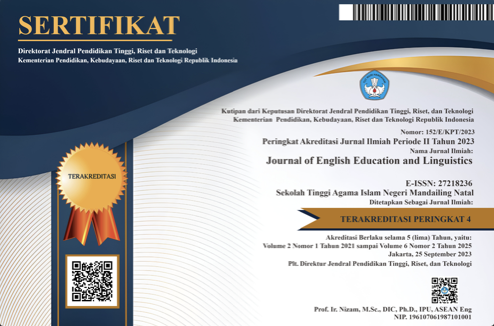THE EFFECTS OF COLLABORATIVE GAMES IN TEACHING ENGLISH LANGUAGE TO STUDENTS
DOI:
https://doi.org/10.56874/jeel.v4iJournal%20of.1196Keywords:
COLLABORATIVE GAMES TEACHING ENGLISH LANGUAGEAbstract
The main objective of this study was to look into the effects of collaborative games in teaching English language to students based on the teacher-made instructional materials for Grade 9 students, administered in the experimental group. This study applied quasi-experimental design wherein two (2) sections of Grade 9 students were involved in the conduct of this study whereas one (1) section made use of the developed intervention (experimental) and the other section employed the lecture-discussion method (control). The pretest yielded that students did not meet expectations or have poor understanding of verbals and literary devices as the lesson objectives; therefore, contextualized collaborative games were made to improve their learning on the topics. Moreover, after the implementation of the intervention to the experimental group, it was found out that the developed instructional materials were effective and created learning improvement on students’ conceptual understanding regarding verbals and literary devices. Thus, the principles of a game-based type of activities or lessons can be an effective strategy in teaching English language specially to academically challenged learners.
References
Richardson, Students have ‘10-minute Attention Span’, retrieved from http://news.bbc.co.uk/2/hi/uk_news/education/8449307. stm, December 1, 2012.
Weinschenk, How many Minutes is the Audience’s Attention Span?, retrieved from http://www.mrmediatraining.com /2012/08/23/how-many-minutes-is-the-audiences-attention span/, December 2, 2012.
http://whatis.techtarget.com/definition/collaboration
Lexicon Universal Encyclopedia. Lexicon Publication. New York, 1983
Wright, Betteridge, Buckby., Games for language learning (3rd ed.). New York: Cambridge University, 2005.
Bennett, The Role of Play and Games in Learning. The 33rd Earl V. Pullias Lecture. University of South California (USC) USA, 2011.
Ersoz, Six games for EFL/ESL classroom. The Internet TESL Journal, 6(6), retrieved from http://iteslj.org/Lessons/Ersoz-Games.html, 2000.
Orlick, Cooperative games and sports: Joyful activities for everyone. Champaign, IL: Human Kinetics, 2006.
Wright, Betteridge, Buckby, Games for language learning (3rd ed.). New York: Cambridge University, 2005.
Ersoz, Six games for EFL/ESL classroom. The Internet TESL Journal, 6(6), retrieved from http://iteslj.org/Lessons/Ersoz-Games.html, 2000.
McFarlane, and Sakellariou, The role of ICT in science education. Cambridge Journal of Education 32(2), 2002, p219-232.
Lengelling, Malarcher, “Index Cards”. A Natural Resource for Teachers, 1997, V. 35, N. 4. Retrieved from http://exchanges . state .govern/forum.
Taduran, Madawac, School Report Lacag National High School, National Achievement Test Result (NAT), 2015.
Sigriður Dögg Sigurðardóttir, The use of games in the language classroom, April 2010.
Consuelo G. Sevillar et. Al., “Research Methods”, Rex Bookstore Co. Inc., Manila Philippines. pp. 101 – 104.
http://www.statisticssolutions.com/quasi-experimental-research-designs/
Literal, Loquinario, “First Quarter English Grades”, Lacag National High School, October 2017.
Marlon Medios Test Validity Rubric/Criteria
http://www.statisticshowto.com/probability-and-statistics/t-test/
Downloads
Published
Issue
Section
License
All articles published in the Journal of English Education and Linguistics are licensed under a Creative Commons Attribution-ShareAlike 4.0 International (CC BY-SA) license. This means anyone is free to copy, transform, or redistribute articles for any lawful purpose in any medium, provided they give appropriate attribution to the original author(s) and Journal of English Education and Linguistics, link to the license, indicate if changes were made, and redistribute any derivative work under the same license.
Copyright on articles is retained by the respective author(s) without restrictions. A non-exclusive license is granted to the Journal of English Education and Linguistics to publish the article and identify itself as its original publisher, along with the commercial right to include the article in a hardcopy issue for sale to libraries and individuals.
Although the conditions of the Creative Commons Attribution-ShareAlike 4.0 International (CC BY-SA) license do not apply to authors (as the copyright holder of your article, you have no restrictions on your rights), by submitting to the Journal of English Education and Linguistics, authors recognize the rights of readers and must grant any third party the right to use their articles to the extent provided by the license.

This work is licensed under a Creative Commons Attribution-ShareAlike 4.0 International License.








